Cumbria orchid: home care
Cambria is a hybrid orchid species that is attractive and easy to care for. Caring for the asterisk orchid (second name) and its maintenance at home does not present any difficulties and problems. That is why it very often flaunts on the windowsills of private houses and apartments, as well as public buildings.
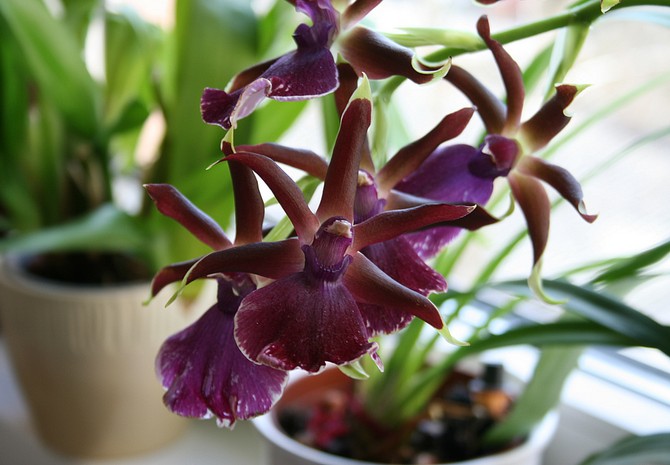
Content
Description of the plant
The Cambria Orchid is an artificially bred hybrid that does not occur in nature. The plant is characterized by the presence of rounded pseudobulbs, and it also has narrow and long leaves that are dark green in color. The indoor flower is characterized by shoot growth.

The shape of the flowers of the culture is quite diverse. They can be star-shaped or rounded. The flower size can be 1-10 centimeters. The flowers of the plant are characterized by yellow, brown, purple or red color.
Video: how to choose the right cambria orchid
Views
There are several varieties of the Cambria orchid.
The most popular types include:
- Beallara, a complex species, in the crossing of which four genera of orchids took part (Miltonia, Brassia, Odontoglossum, Kohlioda);
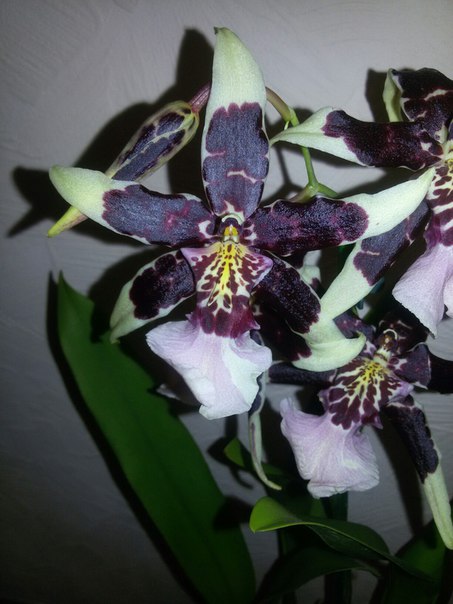
- Burrageara - a complex species, which was obtained by crossing 4 species (Miltonia, Oncidium, Odontoglossum and Kohlioda);
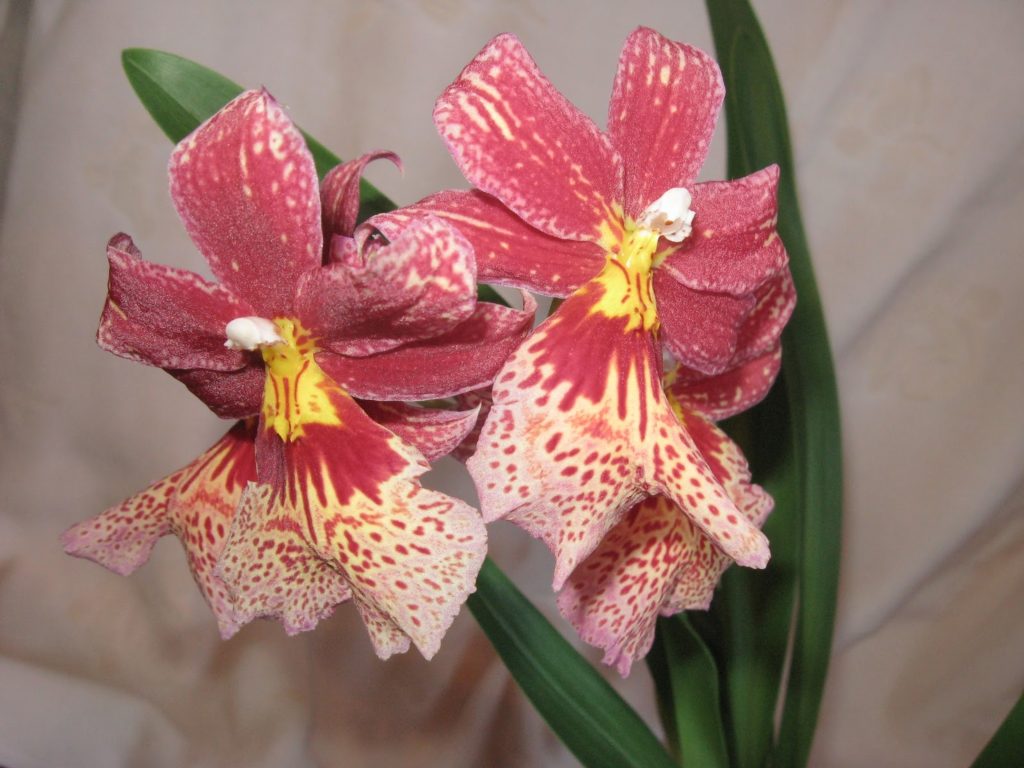
- Colmanara - received by crossing 3 types of orchids: Odontoglossum, Miltonia and Oncidium;
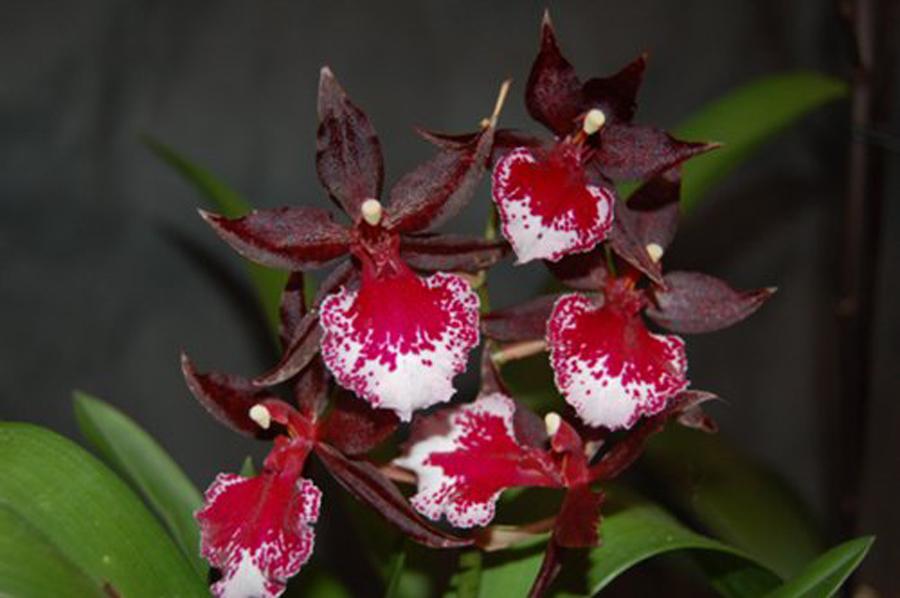
Due to the large number of cambrian orchid species, a florist can choose the most suitable option for himself.
Video: how to distinguish which hybrid Cambria belongs to.
Sometimes (erroneously) cambrian orchid varieties are referred to asMiltassia, but it is crossed by two pure genera of orchids: Miltonia and Brassia - and, therefore, is their variety, i.e.Miltassia is not Cambria.
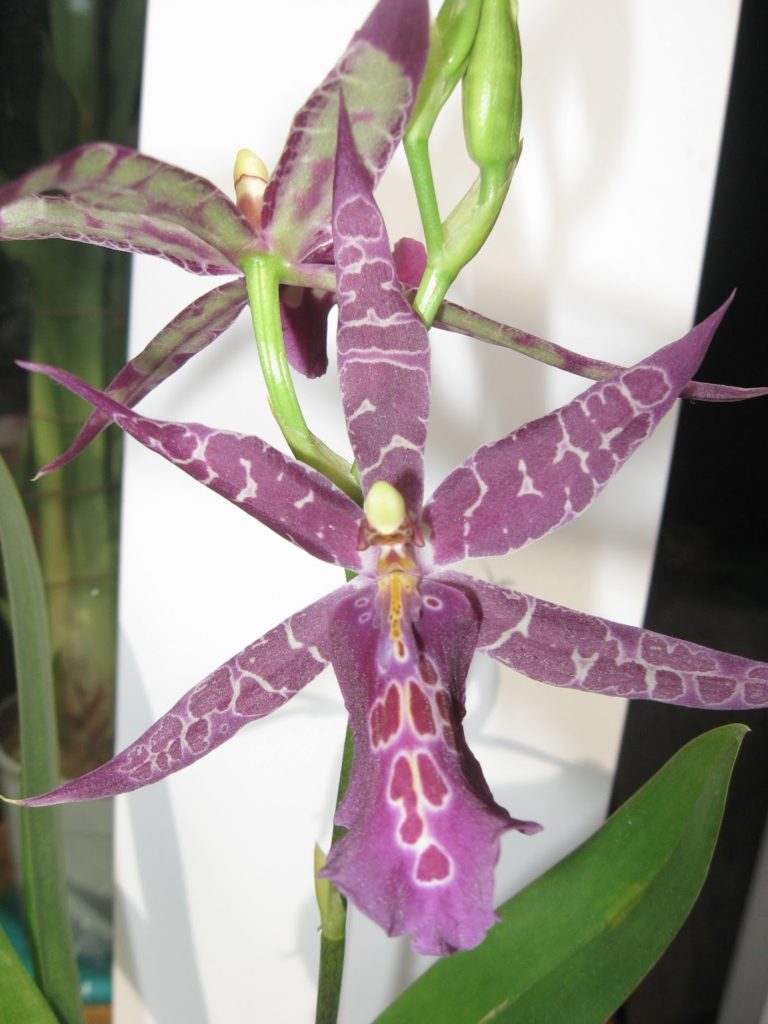
Growing conditions
In order to ensure abundant flowering and rapid growth of the cambrian orchid, it needs to create optimal conditions for growing and keeping, which are given in the table.
| Condition | Content |
| Lighting | Cumbria is a light-loving plant, which is why it must be grown in a well-lit place. In this case, it is strictly forbidden to allow the influence of ultraviolet radiation on the culture. This is due to the possibility of getting burns in the summer, which leads to yellowing of the cambrian leaves.
That is why, if the flower is installed on a south or southeast window, it must be shaded with gauze. The ideal option would be to install the plant on east or west windows. If insufficient lighting is observed in winter, then the flower is placed in the brightest place. If necessary, additional lighting of cambria is organized using phytolamps. Daylight hours should be between 10 and 12 hours. During the dormant period, the culture does not need additional lighting. |
| Temperature | To ensure the normal growth of a flower, it must be kept in a temperature range of 16-21 degrees. Despite the thermophilicity of the orchid, in summer, higher temperatures can negatively affect its growth.
It is best to avoid temperature fluctuations at night. This indicator may differ by no more than 5 degrees. With a greater temperature difference, inflorescences will form. The temperature indicator in the winter period should be at least 14 degrees. It must be ensured, regardless of whether the orchid has flowering. |
| Humidity | This type of orchid is undemanding to air humidity. When a plant is in close proximity to heating devices, it is recommended to increase this indicator.
For this purpose, a container is installed near the pot, which is filled with water. You can also spray the air daily near the orchid foliage. In order to prevent yellow spots from appearing on the leaves of cambria, it is necessary to ensure that no water gets on them during spraying. |
Note! It is believed that the same care is not suitable for each individual species of cambrian orchid, i.e. it is necessary to take into account the peculiarities of those genera of orchids that are introduced into a particular type of cambria, and for this it is necessary to know from which genera of orchids this type of cambria originated (this is described in the previous paragraph).
Thanks to the provision of full-fledged conditions, this orchid variety will delight the eyes of people with its beauty.
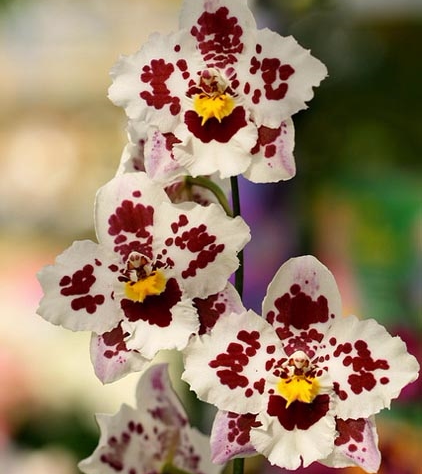
Planting and transplanting
The plant does not need regular replanting. This procedure should be carried out once every several years. Transplanting is carried out if the roots protrude excessively from the pot or the cambrian soil is overly stale.
For transplanting cambria, it is recommended to use an ordinary substrate.In case of excessively dry indoor air, perlite or vermiculite is added to the soil mixture, with the help of which moisture retention will be ensured in the future. The bottom of the pot is settled by drainage, for example from large pieces of bark.
Attention! After the cambria transplant, the bulbs are not sprinkled with the substrate.
It is best to opt for ceramic or plastic pots. The root system of the plant does not tolerate light, which is why it is best to refuse the use of glass containers. The size of the new pot should be several centimeters larger in diameter than the previous one.

After the cambrian orchid transplant, it is not allowed to disturb it for a week.
Important! Watering cambria after transplanting is allowed only after a week.
Video: cambria transplant
Home care secrets
Since the Cambria orchid is characterized by unpretentiousness, anyone can easily take care of it at home. To this end, you just need to follow certain rules.

Watering
Like any other plant, the Cambria orchid needs to be watered periodically. In this case, it is necessary to ensure that the soil mixture dries well between procedures. In summer, on average, Cambria is watered once a week.
Important! In winter, when the temperature drops, the frequency of procedures is significantly reduced.
What is the best way to water cambria? Experts recommend bottom watering. For this purpose, the pot with the orchid is placed in a container that is pre-filled with water. For watering the cambrian orchid, it is recommended to use settled water at room temperature.
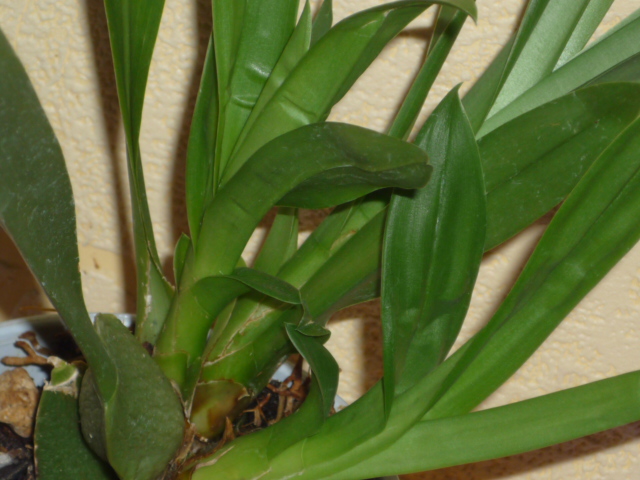
Top dressing
When young shoots appear on the crop, it is necessary to start feeding it, which ends during the flowering period. Cumbria is characterized by a rather delicate root system, which is why, in order to avoid damage to it, it is recommended to use a non-concentrated feed composition. The procedure should be carried out no more than twice a month. Top dressing is carried out by immersing the pot in a solution with fertilizer.

Flowering period
Most often, this type of orchid blooms in the autumn-winter period. In spring and summer, a bulb forms on the shoot, after which a peduncle appears in the leaf axils. To ensure the correct color of the flower and increase the duration of flowering, additional illumination of the culture is necessary.
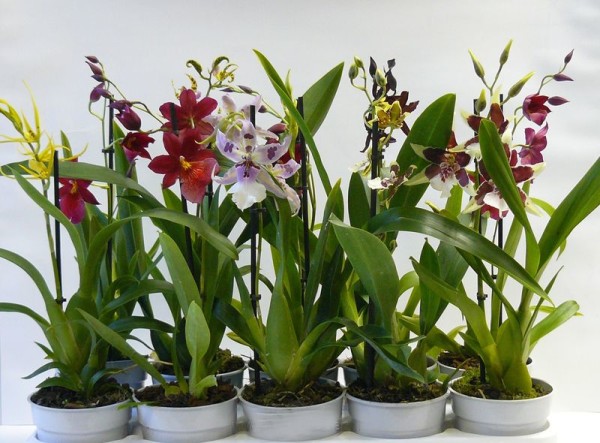
Quite often it happens that the cambrian orchid does not bloom for several years. What to do in this situation? To stimulate flowering, it is recommended to reduce the frequency of watering during the formation of the bulb.
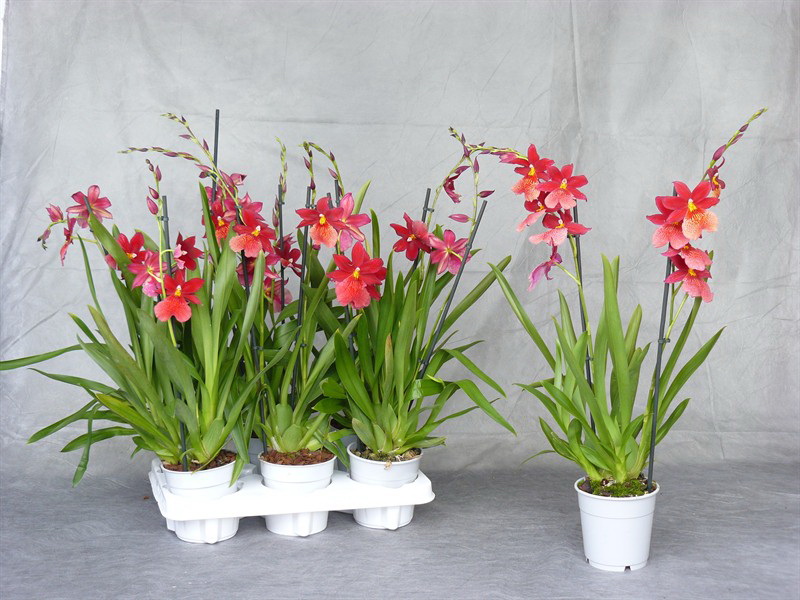
After its formation, it is strictly forbidden to water the orchid for several weeks. After that, light watering is carried out. Thanks to these actions, the orchid will bloom. When one or more peduncles appear in the leaf axils, it is recommended to resume watering.
Note! If at the last stage of the growing season the plant is provided with excessive watering, then this can lead to a lack of flowering.
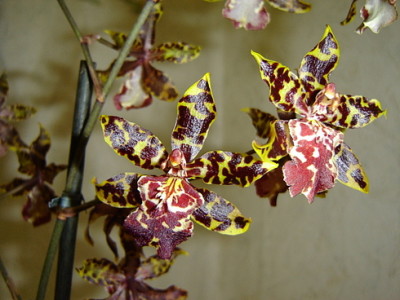
Dormant period
The Asterisk Orchid is characterized by the absence of a dormant period. Despite this, with a decrease in daylight hours in autumn and winter, a decrease in temperature is observed, which leads to a slowdown in crop growth. During this period, watering is reduced and feeding is canceled. After the resumption of growth in early spring, the orchid is provided with full watering and feeding.
There are no special secrets of caring for the cambrian orchid at home, you just need to adhere to all the above tips.
Video: caring for the cambrian orchid at home.
Diseases and pests
With improper and untimely care at home for the cambrian orchid, a variety of diseases and pests can appear on it.
| Name of the disease | Control measures |
| Powdery mildew | Belongs to the category of fungal infections.This disease is characterized by the presence of a characteristic white coating on the leaf. Disease occurs when there is an excess of moisture. If the flower is not treated in time, its death will be observed. For the treatment of the disease, the Skor insecticide is used in accordance with the instructions. |
| Rust | This disease affects orchid foliage. Red spots appear on the inside of the foliage. When this disease appears, it is recommended to remove the lesions with a clerical knife. A 25% alcohol solution is used to treat the cut points. Treatment of the disease is carried out by "Skor", "Ridomil", "Mikosan". |
| Anthracnose | At the initial stages of the course of the disease, small spots appear on the foliage of the culture. After a certain time, they turn black and have a concave surface. After that, there is a yellow or pink bloom on the spots.
Disease appears with an excess of air humidity. In order to avoid the appearance of the disease, it is recommended to periodically ventilate the room. And also in the axils of the foliage, it is necessary to regularly remove the collecting liquid with a sponge, cloth or soft paper napkin. The fight against the disease is carried out with the use of insecticides. |
| Pests | On the orchid, the most common appearance of the scale insects, aphids and the worm. The last one is quite dangerous and can lead to the death of the plant.
In most cases, there is an infection of weak indoor cambrian flowers that are not properly cared for. When pests appear, it is recommended to treat the culture with soapy water. The fight against them is carried out using the appropriate insecticides. Prevention is carried out using a universal remedy, which is developed on the basis of Neem tree oil. |
In order to avoid the appearance of diseases and pests, it is recommended to regularly carry out preventive treatments.
Resuscitation of plants without roots
Thanks to the efforts of breeders, it is possible to save a plant that has no roots. For resuscitation of cambria without roots, most often they are placed in water, to which growth stimulants are previously added.
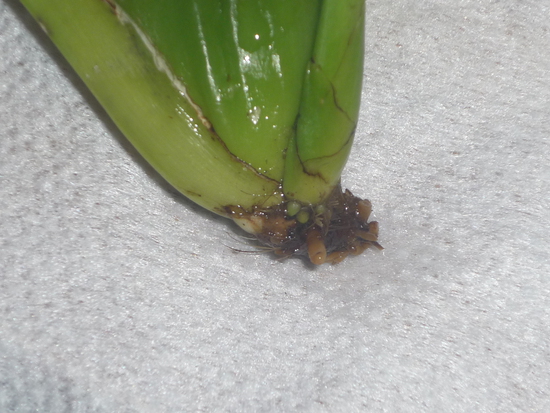
This procedure helps the cambria grow roots. After the appearance of the first roots on the culture during the resuscitation of the cambria in water, it is transplanted into a nutrient soil mixture.
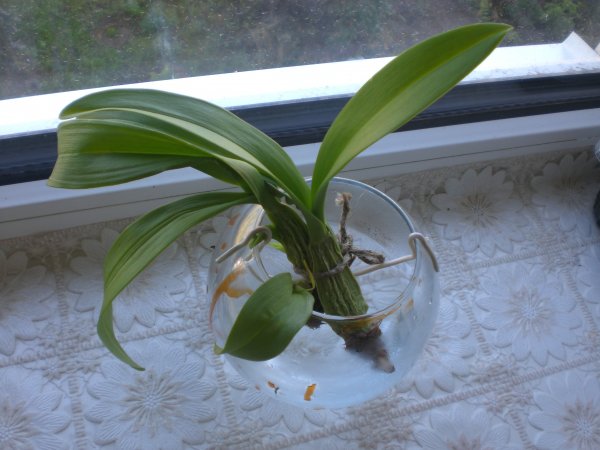
And also cambria without roots can be planted immediately in the ground. For such resuscitation, it is preliminarily placed in a growth stimulator solution. After this, the cut sites are treated with wood ash and the cambria orchid is planted in the ground.
Reproduction
The method of dividing the bush and reproduction by children is most often used for reproduction of the cambrian orchid. Let's talk about each method in more detail.
Reproduction by dividing the bush
This procedure is carried out during plant transplantation. Reproduction of cambria is carried out at the end of the flowering culture.
- Initially, it is necessary to remove the bush from the pot and clean it from the earthy coma.
- It is recommended to carefully examine the root system. If there are diseased roots, they are removed.
- The flower is divided into several parts.
- It is recommended to treat the cuts with wood ash or a solution of potassium permanganate.
- After that, each separate part of the bush is planted in a separate pot.
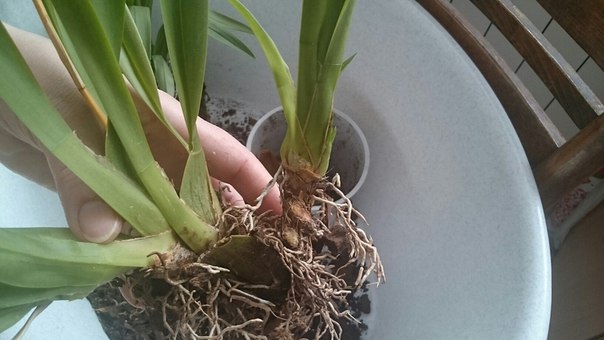
Reproduction by children
Thanks to the efforts of breeders, the plant has children, which are widely used for reproduction of the cambrian orchid at home. When several leaves form on the children, they must be separated from the mother bush.
Some growers place cambrian babies in water in advance, to which growth stimulants are added. After the first roots appear, the flower is planted in a pot. It is also possible to plant cambrian babies in the ground immediately after separation from the mother bush.
The reproduction process of an orchid is quite simple, which any grower can do.Due to the presence of several ways of reproduction of culture, a person can choose the most acceptable option for himself.
Video: reproduction of cambria.
The Cambria Orchid is a very beautiful flower. Due to its ease of care at home, this plant can decorate the windowsills of various premises. To ensure the growth and flowering of the culture, it is recommended to adhere to basic care rules.

